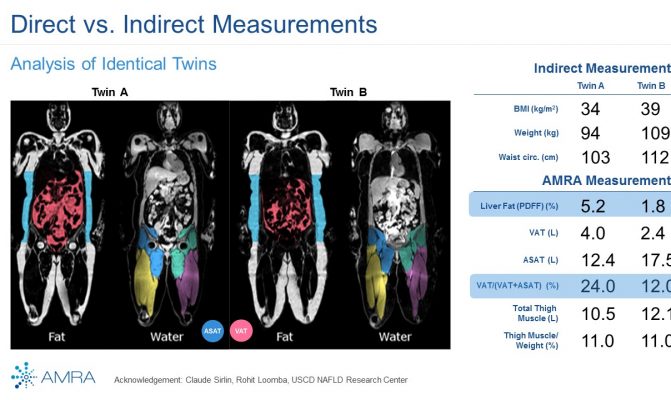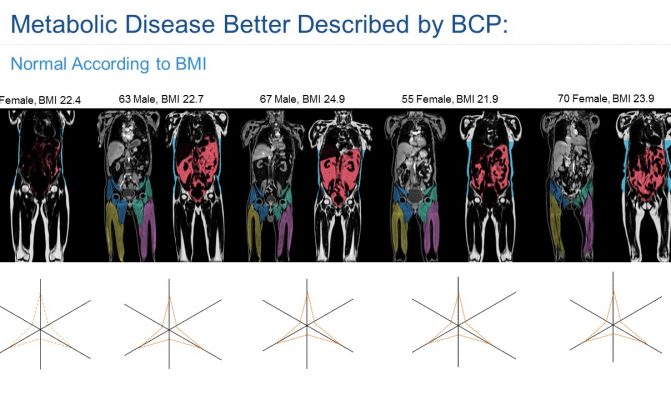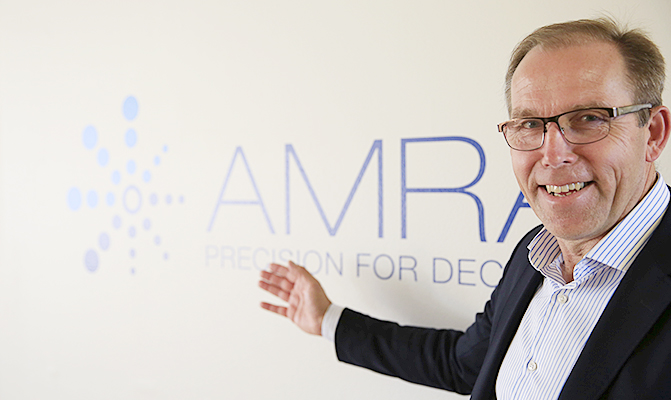What happens to your body if you only eat food from McDonalds for a month? Inspired by Morgan Spurlock’s Supersize Me, the founders of Amra came up with a groundbreaking method of scanning body fat and muscles to prevent disease
In 2010, Swedish PhDs Magnus Borga and Olof Dahlqvist Leinhard, developed a new body composition method, to support a “Supersize Me” study in Linköping. A total of 18 students were only to consume food from McDonald’s for a month’s time – with no exercise allowed. Afterwards, their body fat was measured. But the scientists also wanted to know where the fat ended up in the body. They found out that although the men and women gained about the same amount of weight percentage wise, women tend to store the fat around their thighs and buttocks, as subcutaneous fat, while men usually store it around vital organs in their stomach, as visceral fat.
Supporting the health experiment, the research duo tried a new method of measuring fat and muscles. They soon realised there might be a commercial aspect of the technique. This was to be the start of award winning company Amra.
Measuring your body composition
CEO Tommy Johansson was the first employee at Amra when he was recruited in 2011. Since then, Amra has welcomed an additional 30 talents to their offices in Linköping, Stockholm, Oslo and Dallas (US).
“We use an MRI scanner to take around 700 so called ‘slices’, images with 2-3 mm thickness, of your body and put them together into a 3D model – like a copy of your body,” explains Tommy.
“Each slice is like a picture and we look at small cubes, 2,5 x 2,5 x 2,5 mm. The computer can calculate exactly how much fat or muscles each cube holds.
“You take one picture of the fat and one of the muscles in the body. We use it to measure visceral fat or intra-abdominal fat, which is the fat around the organs. We know this fat increases the risk of cardiovascular disease, diabetes, and some types of cancer. We also look at the amount of fat the patient has in his or her liver, thigh muscles and their muscle volume.
“What is unique about our method is how fast it is. It is only a six minute scan. It is cost efficient at the same time as it offers a very precise analysis.”
The scan is performed via the client’s MRI scanner and the results are sent to Amra via a high security cloud based system where they are analysed and sent back to the client. The report is completed manually in 24 hours, whereas the goal is 10 minutes using a fully automated computer based analysis as the clients often need the result fast.
Areas of usage
Amra’s main clientele can be found in healthcare, executive health, the pharmaceutical industry and universities which carry out research on disease prevention, i.e. diabetes. The scanning technique offers a unique complement to the standardised blood tests by identifying fat storage in the body.
“Your body is the result of genes from our parents and our lifestyle. By scanning patients, we can determine their future risks of heart and liver diseases as well as diabetes,” says Tommy.
“Our technique can help the healthcare determine who to treat and how to treat them. Today you often have to have a heart attack before you get your medical treatment, whereas our method is preventative; we can see who is at high risk before it happens.”
Other potential use for Amra’s technology is to help prioritise who should undergo bariatric surgery, in regard to different fat compositions in the body, or who should undergo rotator cuff surgery.
“Some patients are not suitable candidates for certain types of surgery. We measure the amount of fat infiltration in the muscles to make sure they don’t undergo an unnecessary procedure.”
It is great to make a difference to human kind as obesity is a growing problem. If we can help determining the risks of bad health at an early stage, and prevent disease, that’d be amazing.-Tommy Johansson
Everything is bigger in the US
Unsurprisingly, the biggest market for Amra is the US. Over 50% of Amra’s clients today are based across the pond, where almost 10 % of all adults are diabetics. Storing fat around vital organs as visceral fat poses a greater risk of contracting the disease.
“This is a huge problem in the States. About 75% of all adults are overweight with a BMI over 25. Around 37% are obese with a BMI over 30. England isn’t far behind and the trend is obvious across the world.”
Not only overweight or obese patients are at risk; you can carry life threatening fat around your organs without even knowing it.
“Your exterior doesn’t always reflect what is happening inside of you,” says Tommy.
Projects
Early on, Amra started collaborating with Pfizer and earlier this year they secured a $9 million investment from the pharmaceutical giant. Danish, Novo Seeds, and Swedish Industrifonden have also invested in Amra.
“We have carried out different research studies at around 15 universities in the US, all with the same purpose: to find the connection between body composition and illnesses.”
Another on-going project for Amra is the UK Biobank, in collaboration with Pfizer and Imperial Collage in London. A total of 100 000 people will be scanned, as a part of the world’s largest study including MRI-scans, to understand disease risk based on different body profiles.
“This is priceless to us. The results will convince doctors and health care that our method really works.”
Intellectual Property
Intellectual Property has been key to Amra throughout their journey. Awapatent is the company’s IP partner.
“We have registered several patents to protect different aspects of our concept. Our first patent was the measuring method of the 2,5 x 2,5 x 2,5 mm cubes. We also have a patent for our muscle measuring technique, a patent for measuring the liver and a technical patent for a correction system for measurements.
“IP makes it harder for our competitors to do replicas of our system. It was also crucial for our investors; they were thorough making sure we had our IP in order before they made any investments.”
The name Amra is a registered trademark.
Amra’s IP strategy has taken the possibilities of global expansion in mind. They are currently expanding in both Europe and the US, but the wealthy and overweight Middle East is also a targeted market.
Visualisation
“It is great to make a difference to human kind as obesity is a growing problem. If we can help determining the risks of bad health at an early stage, and prevent disease, that’d be amazing,” says Tommy.
“We hope to play a part in people taking their health seriously and understanding it. Our goal is to detect and prevent illnesses caused from obesity.”
He adds:
“One of our colleagues agreed to be a volunteer for a test scan when we were validating a new MRI scanner a couple of years ago. He was shocked to find out how much fat he was carrying around his organs. Every time I meet him now, he eats salads for lunch and has lost a whopping 20 kg. You can’t underestimate the effect of a visualisation of what is going on inside your body. It can be a massive motivator.”
Amra
For more information on Amra, please visit amra.se
For their IP matters, Amra has been consulted by Ulf Willquist at Awapatent’s Linköping Office.









